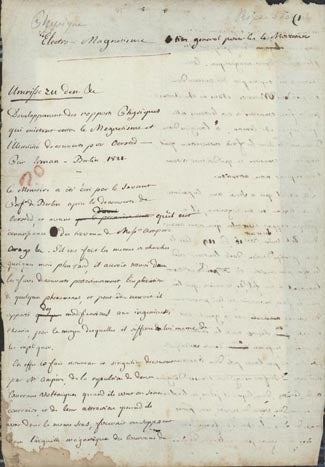
Autograph Manuscript on Oersted's discovery of electro-magnetism
Publisher Information: Geneva: 1820.
[La Rive, Gaspard de (1770-1834)] Electro-Magnetisme-titre general pour les l[ivres] nouveaux. Umrisse zu den &c. [Review of Umrisse zu den physischen verhaltnissen des von Herrn Professor Oersted entdeckten elektro-chemischen Magnetismus (1821), by Paul Erman (1764-1851)] Incomplete autograph manuscript draft, consisting of the title, the first two paragraphs and a good portion of the third. 2 pp. 277 x 190 mm. Written chiefly on the left column of a sheet folded into two columns, allowing for revisions. Creased where previously folded, small dampstain in lower corner, one upper corner a little chipped, but otherwise very good.
An intriguing autograph manuscript review of Paul Erman's Umrisse zu den physischen verhaltnissen des von Herrn Professor Oersted entdeckten elektro-chemischen Magnetismus (1821), reflecting the extraordinary ferment in physical science aroused by the recent discoveries of Oersted, Ampère, Arago and others re the relationship of electricity and magnetism. The review was written for the Bibliothèque Universelle, Geneva's foremost scientific and literary review, by Gaspard de la Rive, an editor of this journal and himself a physicist and experimenter in electrical science whose work is summarized in the D.S.B.; he is best known for his defense and helpful criticism of Ampère's theory of magnetism. The present review focuses on the work of Paul Erman, professor of physics at the University of Berlin and perpetual secretary of Berlin's Royal Academy. The review is certainly closely connected with Ampère's work, and, according to Ampère's most recent biographer, James R. Hofmann, the account of Erman's experiments contained in it influenced Ampère's investigations of induction in July 1821, in which he very nearly anticipated Faraday's landmark discovery of electromagnetic induction a decade later. The third paragraph of La Rive's work may be translated as follows: The apparatus used in M. Erman's experiments is very ingenious; it bears some resemblance to that which we described [in] Bib. Univ. vol. 16 s. 119. It is the same principle of action, whose effects the author renders more obvious by suspending the entire apparatus from a wire, in such a way that one can make it move by presenting magnets on either its right or its left side; one thus observes the rotation movements printed on a voltaic [carde?] by one or the other pole of a bar magnet. He makes use of a silver or copper crucible, in which he places a small amount of zinc, isolated by means of a watch-glass; the chain between the zinc and copper is formed by a band of zinc. . . . The first sentence in the above paragraph refers to La Rive's own "flotteur électrique," a simple device demonstrating the action of a magnet on a simple current loop, which was first described in La Rive's "Notices sur quelques expériences électro-magnétiques" published in Vol. 16 of the Bibliothèque Universelle (1821). Hofmann, in his account of Ampère's July 1821 induction experiments, notes the influence of both Erman and La Rive on Ampère's work:
An interesting experiment by Paul Erman caught Ampère's eye when it was reported in the Bibliothèque Universelle early in 1821 [i.e. most probably in the published review of which we are offering the manuscript draft]. . . . Erman had used a bar magnet detector in his own experiment; Ampère would use bar magnets in 1821. . . . Similarly, in March, 1821, Gaspard de La Rive had used a bar magnet to demonstrate attractions and repulsions of a vertical current loop. Consequently, by early in 1821 Ampère was thoroughly familiar with apparatus in which steady currents in vertical current loops were rotated using magnets (Hofmann, André-Marie Ampère, [1995] pp. 284-85).
Earlier in his review La Rive notes that Erman wrote his work after Oersted's discovery of electromagnetism (spring 1820), but before learning of the researches of Ampère and Arago that began the following September. He refers to Ampère's discovery of the relationship of current-flow to magnetism (1820) as "le fait nouveau et singulier decouvert par M. Ampère, . . . [qui] fournit en supposent dans l'aguille magnetique des courrans de meme nature, une explication claire simple et satisfaisant de la plupart des phenomenes electro-magnetiques" [the new and singular fact discovered by M. Ampère, . . . [which], supposing that the currents in a magnetic needle are of the same nature, provides a clear, simple and satisfying explanation of most electromagnetic phenomena].
Study of the bibliography of Ampère's writings published by Hofmann confirms that in 1821 Ampère published 8 papers, of which no less than 5 appeared in La Rive's Bibliothèque Universelle des Sciences, Belles-lettres et Arts. One of these was entitled "Lettre de M. Ampère à M. Erman . . . ." Another paper published slightly later in the year was entitled "Extrait d'une lettre de Mr. Ampère au Prof. De La Rive". This manuscript fragment, representing certainly a major portion of La Rive's review, was preserved in a Victorian album of 120 autographs by scientists and explorers we recently acquired. It was the first document preserved in the album, and was misidentified by the member of the Paget family who put the album together. Why this particular leaf was preserved without its conclusion will remain a mystery. A complete transcription and translation of the document is attached.
Book Id: 32310Price: $1,500.00
